美国加州65号法案(Proposition 65)与咖啡致癌案
- 格式:doc
- 大小:26.50 KB
- 文档页数:7
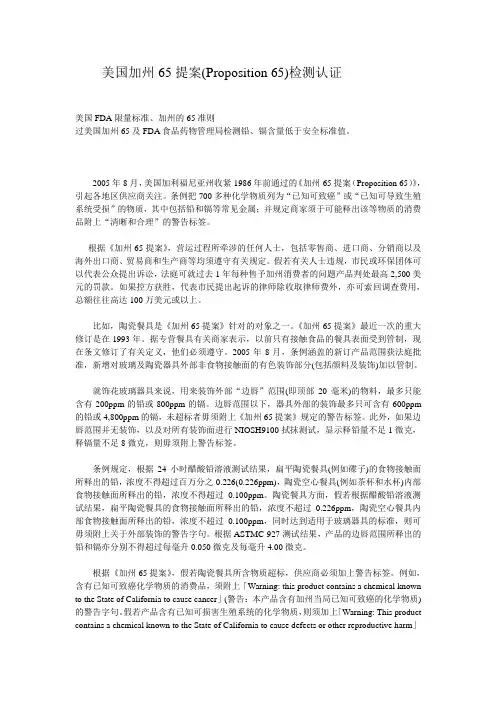
美国加州65提案(Proposition 65)检测认证美国FDA限量标准、加州的65准则过美国加州 65 及 FDA 食品药物管理局检测铅、镉含量低于安全标准值。
2005年8月,美国加利福尼亚州收紧1986年前通过的《加州65提案(Proposition 65)》,引起各地区供应商关注。
条例把700多种化学物质列为“已知可致癌”或“已知可导致生殖系统受损”的物质,其中包括铅和镉等常见金属;并规定商家须于可能释出该等物质的消费品附上“清晰和合理”的警告标签。
根据《加州65提案》,营运过程所牵涉的任何人士,包括零售商、进口商、分销商以及海外出口商、贸易商和生产商等均须遵守有关规定。
假若有关人士违规,市民或环保团体可以代表公众提出诉讼,法庭可就过去1年每种售予加州消费者的问题产品判处最高2,500美元的罚款。
如果控方获胜,代表市民提出起诉的律师除收取律师费外,亦可索回调查费用,总额往往高达100万美元或以上。
比如,陶瓷餐具是《加州65提案》针对的对象之一。
《加州65提案》最近一次的重大修订是在1993年。
据专营餐具有关商家表示,以前只有接触食品的餐具表面受到管制,现在条文修订了有关定义,他们必须遵守。
2005年8月,条例涵盖的新订产品范围获法庭批准,新增对玻璃及陶瓷器具外部非食物接触面的有色装饰部分(包括颜料及装饰)加以管制。
就饰花玻璃器具来说,用来装饰外部“边唇”范围(即顶部20毫米)的物料,最多只能含有200ppm的铅或800ppm的镉。
边唇范围以下,器具外部的装饰最多只可含有600ppm 的铅或4,800ppm的镉,未超标者毋须附上《加州65提案》规定的警告标签。
此外,如果边唇范围并无装饰,以及对所有装饰面进行NIOSH9100拭抹测试,显示释铅量不足1微克,释镉量不足8微克,则毋须附上警告标签。
条例规定,根据24小时醋酸铅溶液测试结果,扁平陶瓷餐具(例如碟子)的食物接触面所释出的铅,浓度不得超过百万分之0.226(0.226ppm),陶瓷空心餐具(例如茶杯和水杯)内部食物接触面所释出的铅,浓度不得超过0.100ppm。
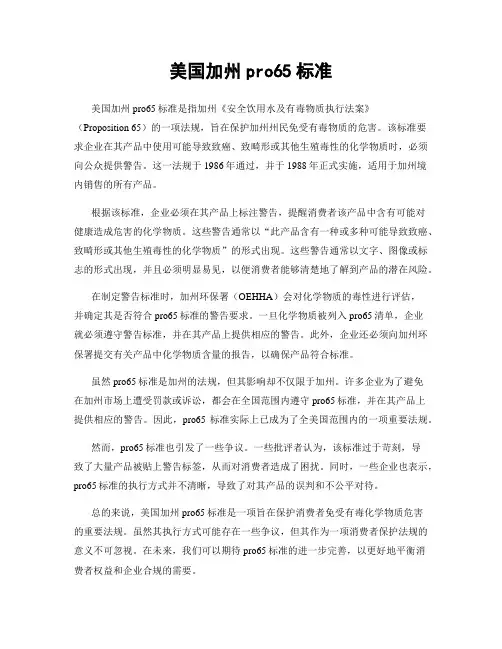
美国加州pro65标准美国加州pro65标准是指加州《安全饮用水及有毒物质执行法案》(Proposition 65)的一项法规,旨在保护加州州民免受有毒物质的危害。
该标准要求企业在其产品中使用可能导致致癌、致畸形或其他生殖毒性的化学物质时,必须向公众提供警告。
这一法规于1986年通过,并于1988年正式实施,适用于加州境内销售的所有产品。
根据该标准,企业必须在其产品上标注警告,提醒消费者该产品中含有可能对健康造成危害的化学物质。
这些警告通常以“此产品含有一种或多种可能导致致癌、致畸形或其他生殖毒性的化学物质”的形式出现。
这些警告通常以文字、图像或标志的形式出现,并且必须明显易见,以便消费者能够清楚地了解到产品的潜在风险。
在制定警告标准时,加州环保署(OEHHA)会对化学物质的毒性进行评估,并确定其是否符合pro65标准的警告要求。
一旦化学物质被列入pro65清单,企业就必须遵守警告标准,并在其产品上提供相应的警告。
此外,企业还必须向加州环保署提交有关产品中化学物质含量的报告,以确保产品符合标准。
虽然pro65标准是加州的法规,但其影响却不仅限于加州。
许多企业为了避免在加州市场上遭受罚款或诉讼,都会在全国范围内遵守pro65标准,并在其产品上提供相应的警告。
因此,pro65标准实际上已成为了全美国范围内的一项重要法规。
然而,pro65标准也引发了一些争议。
一些批评者认为,该标准过于苛刻,导致了大量产品被贴上警告标签,从而对消费者造成了困扰。
同时,一些企业也表示,pro65标准的执行方式并不清晰,导致了对其产品的误判和不公平对待。
总的来说,美国加州pro65标准是一项旨在保护消费者免受有毒化学物质危害的重要法规。
虽然其执行方式可能存在一些争议,但其作为一项消费者保护法规的意义不可忽视。
在未来,我们可以期待pro65标准的进一步完善,以更好地平衡消费者权益和企业合规的需要。
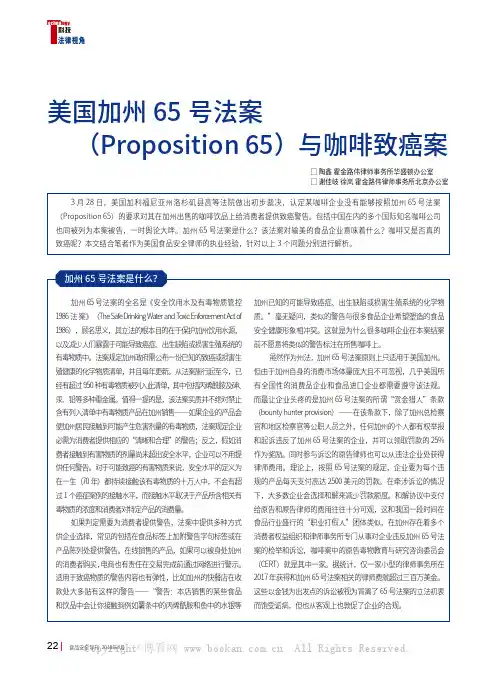
法律视角Tlogy科技22 食品安全导刊 2018年8月美国加州65号法案(Proposition 65)与咖啡致癌案□ 陶鑫 霍金路伟律师事务所华盛顿办公室□ 谢佳岐 徐岚 霍金路伟律师事务所北京办公室加州65号法案是什么?加州已知的可能导致癌症、出生缺陷或损害生殖系统的化学物质。
”毫无疑问,类似的警告与很多食品企业希望塑造的食品安全健康形象相冲突。
这就是为什么很多咖啡企业在本案结案前不愿意将类似的警告标注在所售咖啡上。
虽然作为州法,加州65号法案原则上只适用于美国加州。
但由于加州自身的消费市场体量庞大且不可忽视,几乎美国所有全国性的消费品企业和食品进口企业都需要遵守该法规。
而最让企业头疼的是加州65号法案的所谓“赏金猎人”条款(bounty hunter provision)——在该条款下,除了加州总检察官和地区检察官等公职人员之外,任何加州的个人都有权举报和起诉违反了加州65号法案的企业,并可以领取罚款的25%作为奖励。
同时参与诉讼的原告律师也可以从违法企业处获得律师费用。
理论上,按照65号法案的规定,企业要为每个违规的产品每天支付高达2500美元的罚款。
在牵涉诉讼的情况下,大多数企业会选择和解来减少罚款额度。
和解协议中支付给原告和原告律师的费用往往十分可观,这和我国一段时间在食品行业盛行的“职业打假人”团体类似,在加州存在着多个消费者权益组织和律师事务所专门从事对企业违反加州65号法案的检举和诉讼,咖啡案中的原告毒物教育与研究咨询委员会(CERT)就是其中一家。
据统计,仅一家小型的律师事务所在2017年获得和加州65号法案相关的律师费就超过三百万美金。
这些以金钱为出发点的诉讼被视为背离了65号法案的立法初衷而饱受诟病,但也从客观上也敦促了企业的合规。
加州65号法案的全名是《安全饮用水及有毒物质管控1986法案》(The Safe Drinking W ater and T oxic Enforc ement Act of 1986),顾名思义,其立法的根本目的在于保护加州饮用水源,以及减少人们暴露于可能导致癌症、出生缺陷或损害生殖系统的有毒物质中。

加利福尼亚州65号法案警示语加利福尼亚州65号法案最初于1986年通过,并在随后的几年内进行了多次修订。
该法案适用于几乎所有在加利福尼亚州生产、分销或销售的产品,包括化妆品、食品、药品、家具、汽车和建筑材料等。
根据该法案的规定,如果产品中含有被认定为致癌、致敏或其他对健康有害的化学物质,生产商和零售商必须提供警告标签或书面通知,以通知消费者潜在的危险。
虽然加利福尼亚州65号法案旨在保护消费者,但该法案也受到批评。
一些企业和利益集团认为该法案不够准确或公平,因为它可以导致产品被过度标记或引起不必要的恐慌。
此外,一些批评者还指出,该法案可能给企业带来额外的成本和法律风险,使其更加谨慎地选择在加州市场销售产品。
不过,加利福尼亚州65号法案的支持者认为,该法案是一项重要的保护措施,可以帮助消费者做出更明智的购买决定并促使企业更负责任地管理其产品。
他们认为,公众有权知道他们所购买的产品可能存在的潜在危险,以便他们能够采取必要的预防措施或选择避免使用这些产品。
对于消费者来说,了解加利福尼亚州65号法案的基本内容和要求是非常重要的。
如果你购买的产品上带有65号法案的警告标签,那么你应该仔细阅读并理解这些警告的含义。
也许你可以考虑选择其他替代产品,以减少您的潜在暴露风险。
在选择购买产品时,消费者可以采取一些措施来保护自己免受潜在危害。
首先,要注意产品的标签和警告信息。
其次,可以选择购买认证的有机产品或持有合格认证的标志。
此外,要避免长时间暴露于有害化学品,应尽量减少使用化学清洁剂和化妆品。
加利福尼亚州65号法案的实施对企业也有一定的影响。
为了遵守法规,企业需要密切关注其产品的化学成分,并确保符合法律标准。
他们可能需要进行额外的测试和评估,以确定产品是否存在潜在的危险物质。
此外,企业可能需要更改其生产流程,以减少或完全消除有害物质的使用。
总的来说,加利福尼亚州65号法案是一项重要的法规,旨在保护公众免受潜在有害物质的危害。
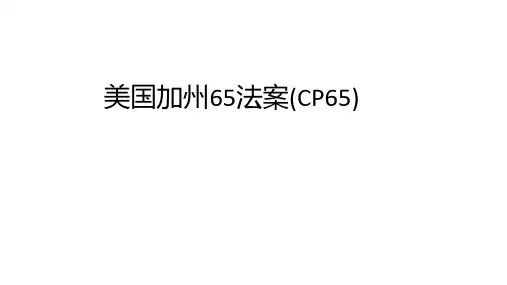
美国加州65法案(CP65)Contentsl CP65号提案(安全饮用水和有毒物质强制法令)l CP65提案的核心要求l化学品如何添加到加州65号提案中l CP65管控物质l企业如何应对l警告条款更新l警告标签要求l2020年加州65处罚案例汇总l加州65法案对化学品的某些结案案例要点l CP65和RoHS 2.0CP65号提案(安全饮用水和有毒物质强制法令)颁布实施时间:后被编纂列入加利福尼亚州健康和安全法典的25249.5-25249.13章。
涉及产品:珠宝、玩具、电气装置、玻璃陶瓷材料、服装、饰物、药、农药、染料、化妆品、礼品、制造或施工用品、化学过程的副产品如汽车尾气、烟雾、天然气燃烧等,几乎覆盖了所有的产品,并对危险品的暴露场景进行列明。
宗旨:保护美国加州居民及该州的饮用水水源,使水源不含已知可能导致癌症、出生缺陷或其他生殖发育危害的物质,并在出现该类物质时如实通知居民。
CP65提案的核心要求√ 不容许将提案列明的危险物质排放到饮用水里。
√提供清晰且合理的警告豁免:雇员少于10人的企业或政府机构可解除到的化学物质含量非常低,不至于产生重大致癌或致畸或其他生产危害(难以证明)某一种化学物质归入了第65号提案清单之列,制造商和经销商将须在一年内完成警告的执行,在20个月内终止化学物质排放至饮用水源头。
此日期过后,政府或个人执法者,包括代表公众利益的个人或组织,可对未达标者采取法律行为。
化学品如何添加到加州65号提案中加利福尼亚州必须至少每年更新一次有害化学品清单,有四种情况下化学物质可以被添加到列表中。
1.劳动法典(LC)世界卫生组织国际癌症研究机构确定的化学物质是人类或动物癌症的原因。
2.州的合格专家(SQE)如果两个独立的科学和健康专家委员会发现该化学物质会导致癌症,先天缺陷或其他生殖危害,则可添加化学品。
致癌物质鉴定委员会(CIC)和发育和生殖毒物鉴定委员会(DARTIC)每年举行一次会议,以评估属于第65号提案的化学品。
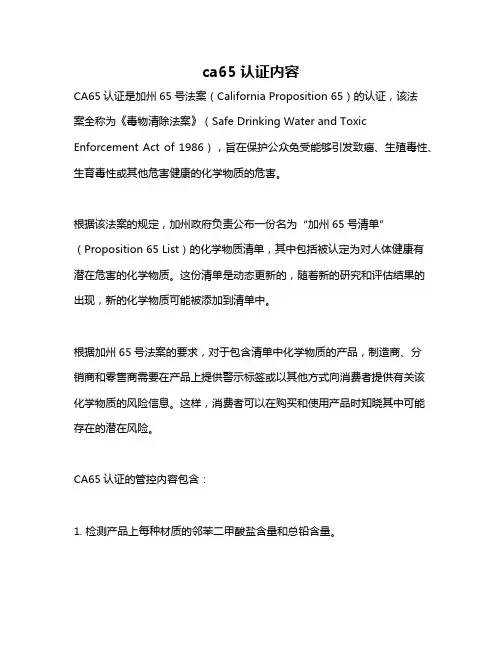
ca65认证内容
CA65认证是加州65号法案(California Proposition 65)的认证,该法
案全称为《毒物清除法案》(Safe Drinking Water and Toxic Enforcement Act of 1986),旨在保护公众免受能够引发致癌、生殖毒性、生育毒性或其他危害健康的化学物质的危害。
根据该法案的规定,加州政府负责公布一份名为“加州65号清单”(Proposition 65 List)的化学物质清单,其中包括被认定为对人体健康有潜在危害的化学物质。
这份清单是动态更新的,随着新的研究和评估结果的出现,新的化学物质可能被添加到清单中。
根据加州65号法案的要求,对于包含清单中化学物质的产品,制造商、分
销商和零售商需要在产品上提供警示标签或以其他方式向消费者提供有关该化学物质的风险信息。
这样,消费者可以在购买和使用产品时知晓其中可能存在的潜在风险。
CA65认证的管控内容包含:
1. 检测产品上每种材质的邻苯二甲酸盐含量和总铅含量。
2. 管控的物质种类比较多,设计的产品范围包含珠宝、纺织服装、玩具以及电子电器类。
3. 杜绝饮用水源污染,任何企业不得有意排放或释放致癌性物质或有生殖毒性物质进入水源或可能污染到水源的土地中。
4. 对于加州65法规中列出的物质,需提供清晰合理的警告(除非暴露水平很低,不会构成风险)。
有毒物质暴露大于管控水平时,企业需提供加州
65警示。
当某一种化学物质被列入法规清单,需在一年内完成警告的执行,20个月内终止化学物质排放至饮用水源头。
如需了解更多关于CA65认证的内容,建议咨询相关专业人员获取帮助。
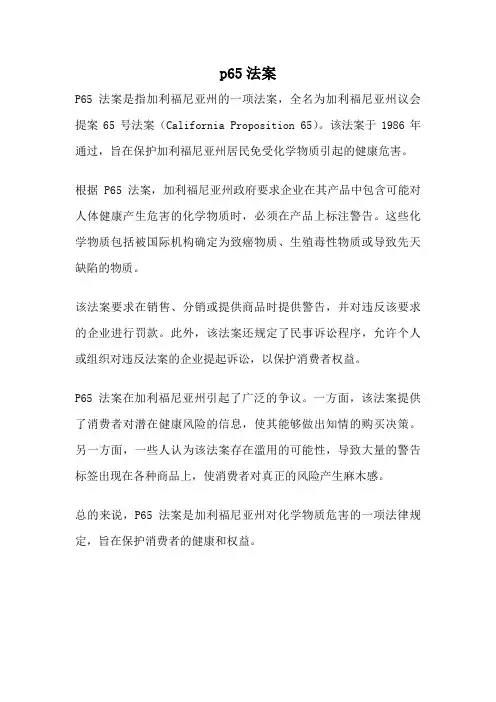
p65法案
P65法案是指加利福尼亚州的一项法案,全名为加利福尼亚州议会提案65号法案(California Proposition 65)。
该法案于1986年通过,旨在保护加利福尼亚州居民免受化学物质引起的健康危害。
根据P65法案,加利福尼亚州政府要求企业在其产品中包含可能对人体健康产生危害的化学物质时,必须在产品上标注警告。
这些化学物质包括被国际机构确定为致癌物质、生殖毒性物质或导致先天缺陷的物质。
该法案要求在销售、分销或提供商品时提供警告,并对违反该要求的企业进行罚款。
此外,该法案还规定了民事诉讼程序,允许个人或组织对违反法案的企业提起诉讼,以保护消费者权益。
P65法案在加利福尼亚州引起了广泛的争议。
一方面,该法案提供了消费者对潜在健康风险的信息,使其能够做出知情的购买决策。
另一方面,一些人认为该法案存在滥用的可能性,导致大量的警告标签出现在各种商品上,使消费者对真正的风险产生麻木感。
总的来说,P65法案是加利福尼亚州对化学物质危害的一项法律规定,旨在保护消费者的健康和权益。
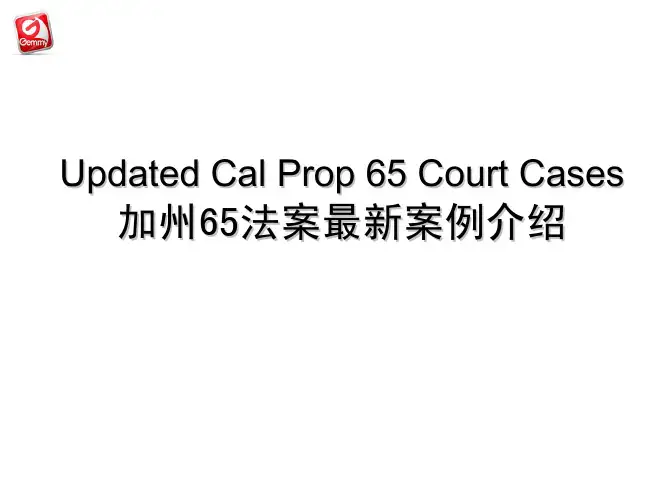
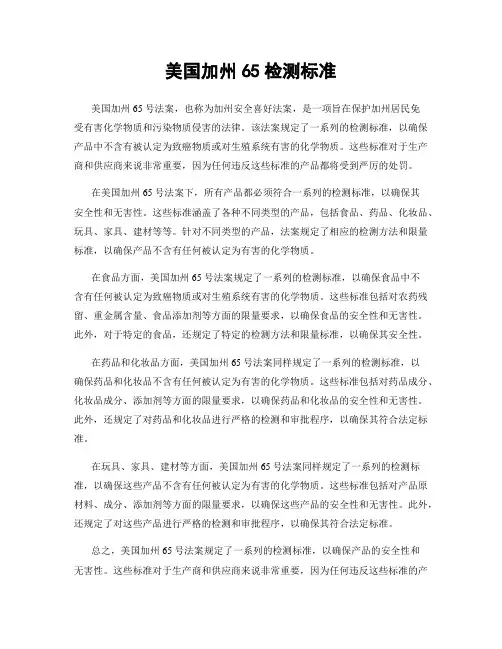
美国加州65检测标准美国加州65号法案,也称为加州安全喜好法案,是一项旨在保护加州居民免受有害化学物质和污染物质侵害的法律。
该法案规定了一系列的检测标准,以确保产品中不含有被认定为致癌物质或对生殖系统有害的化学物质。
这些标准对于生产商和供应商来说非常重要,因为任何违反这些标准的产品都将受到严厉的处罚。
在美国加州65号法案下,所有产品都必须符合一系列的检测标准,以确保其安全性和无害性。
这些标准涵盖了各种不同类型的产品,包括食品、药品、化妆品、玩具、家具、建材等等。
针对不同类型的产品,法案规定了相应的检测方法和限量标准,以确保产品不含有任何被认定为有害的化学物质。
在食品方面,美国加州65号法案规定了一系列的检测标准,以确保食品中不含有任何被认定为致癌物质或对生殖系统有害的化学物质。
这些标准包括对农药残留、重金属含量、食品添加剂等方面的限量要求,以确保食品的安全性和无害性。
此外,对于特定的食品,还规定了特定的检测方法和限量标准,以确保其安全性。
在药品和化妆品方面,美国加州65号法案同样规定了一系列的检测标准,以确保药品和化妆品不含有任何被认定为有害的化学物质。
这些标准包括对药品成分、化妆品成分、添加剂等方面的限量要求,以确保药品和化妆品的安全性和无害性。
此外,还规定了对药品和化妆品进行严格的检测和审批程序,以确保其符合法定标准。
在玩具、家具、建材等方面,美国加州65号法案同样规定了一系列的检测标准,以确保这些产品不含有任何被认定为有害的化学物质。
这些标准包括对产品原材料、成分、添加剂等方面的限量要求,以确保这些产品的安全性和无害性。
此外,还规定了对这些产品进行严格的检测和审批程序,以确保其符合法定标准。
总之,美国加州65号法案规定了一系列的检测标准,以确保产品的安全性和无害性。
这些标准对于生产商和供应商来说非常重要,因为任何违反这些标准的产品都将受到严厉的处罚。
因此,生产商和供应商应当严格遵守这些标准,确保其产品符合法定标准,以保障消费者的权益和健康。
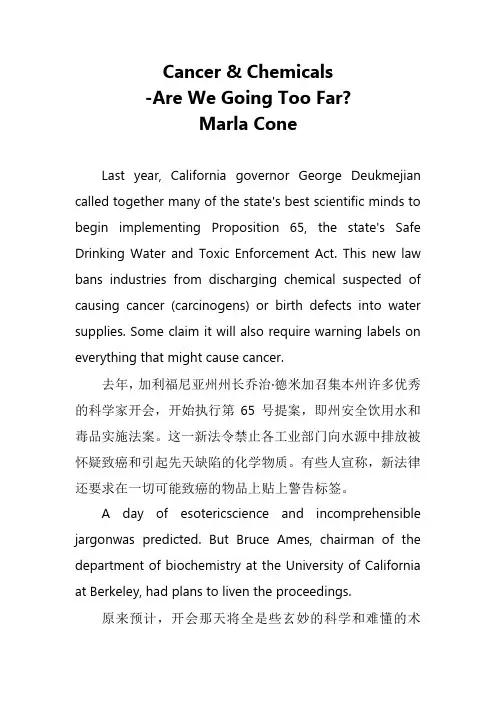
Cancer & Chemicals-Are We Going Too Far?Marla ConeLast year, California governor George Deukmejian called together many of the state's best scientific minds to begin implementing Proposition 65, the state's Safe Drinking Water and Toxic Enforcement Act. This new law bans industries from discharging chemical suspected of causing cancer (carcinogens) or birth defects into water supplies. Some claim it will also require warning labels on everything that might cause cancer.去年,加利福尼亚州州长乔治·德米加召集本州许多优秀的科学家开会,开始执行第65号提案,即州安全饮用水和毒品实施法案。
这一新法令禁止各工业部门向水源中排放被怀疑致癌和引起先天缺陷的化学物质。
有些人宣称,新法律还要求在一切可能致癌的物品上贴上警告标签。
A day of esotericscience and incomprehensible jargonwas predicted. But Bruce Ames, chairman of the department of biochemistry at the University of California at Berkeley, had plans to liven the proceedings.原来预计,开会那天将全是些玄妙的科学和难懂的术语,但加州大学伯克利分校生物化学系系主任布鲁斯·爱姆兹却打算使会议开得更有生气。
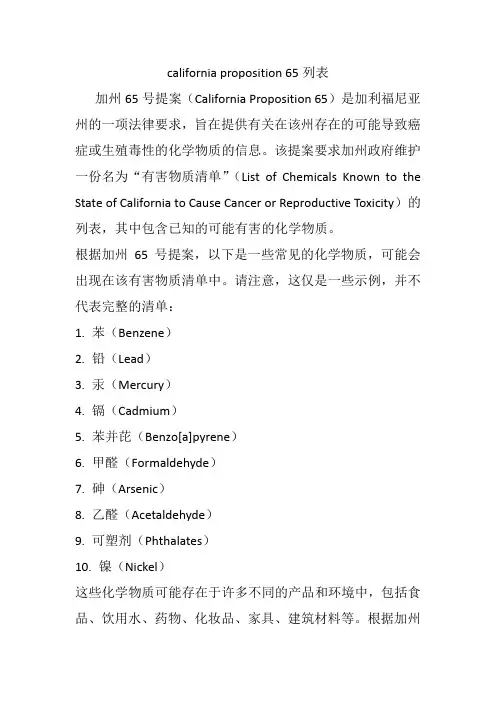
california proposition 65列表加州65号提案(California Proposition 65)是加利福尼亚州的一项法律要求,旨在提供有关在该州存在的可能导致癌症或生殖毒性的化学物质的信息。
该提案要求加州政府维护一份名为“有害物质清单”(List of Chemicals Known to the State of California to Cause Cancer or Reproductive Toxicity)的列表,其中包含已知的可能有害的化学物质。
根据加州65号提案,以下是一些常见的化学物质,可能会出现在该有害物质清单中。
请注意,这仅是一些示例,并不代表完整的清单:1. 苯(Benzene)2. 铅(Lead)3. 汞(Mercury)4. 镉(Cadmium)5. 苯并芘(Benzo[a]pyrene)6. 甲醛(Formaldehyde)7. 砷(Arsenic)8. 乙醛(Acetaldehyde)9. 可塑剂(Phthalates)10. 镍(Nickel)这些化学物质可能存在于许多不同的产品和环境中,包括食品、饮用水、药物、化妆品、家具、建筑材料等。
根据加州65号提案的规定,如果产品中含有该有害物质清单中的任何一种化学物质,制造商、分销商或零售商需要提供警告,以使消费者能够知晓潜在的危险。
请注意,有害物质清单是根据科学研究和相关机构的评估编制的,并且可能会定期更新。
如果您需要最新的有害物质清单信息,建议查阅加利福尼亚州环境保护局(California Environmental Protection Agency)或加利福尼亚州劳工部(California Department of Labor)的官方网站,以获取最新的清单和相关信息。
2015-08-03 14:42:28加州65更新有害物质管控清单背景介绍加州65号提案即《1986年饮用水安全与毒性物质强制执行法》,1986年11月颁发,其宗旨是保护美国加州居民及该州的饮用水水源,使水源不含已知可能导致癌症、出生缺陷或其他生殖发育危害的物质,并在产品出现该类物质时如实通知居民。
加州65管控物质清单由OEHHA出台并每季度更新,首次出版于1987年,最新清单中物质已达900多种。
核心管控要求1、禁止引用水源污染:任何人在经营过程中不得有意排放或释放加州所知的致癌性或有生殖毒性的物质进入水源或投放到可能污染水源的土地上或土地中。
2、警示要求:某一种化学物质被列入管控清单后,制造商和经销商须在12个月内完成警告的执行,在20个月内终止化学物质排放至饮用水源头。
此日期过后,政府或个人执法者,包括代表公众利益的个人或组织,可对违反法规者提起诉讼。
3、有害物质限量要求:加州65法案管控清单本身并未对物质设定限值,产品中有害物质的管控限值,参考已有的针对此类产品的诉讼案或协议,这些文件中,可能会达成针对某类产品中某些物质的限值要求以及测试方法。
4、企业在进行加州65管控时,首先应比对已有的此类产品的诉讼案中确定的物质管控要求,然后参考此管控来调查产品中的有害物质。
CTI建议加州65本身并未规定具体管控产品类别,但是由于法案制定的目的是为了避免有害物质进入加州水源,所以,理论上来说,一切含有有害物质的产品都在其管控范围内,企业可以关注法规新增加的以及高风险的化学物质。
展开供应链调查,必要时可以进行检测,以降低产品违规风险。
2015-11-16 15:09:12加州65欲添加五氯苯酚类物质到有害物质清单背景介绍1986年11月,加利福尼亚州颁布《1986年饮用水安全与毒性物质强制执行法》,即美国加利福尼亚州关于增加对可接触的有毒化学物质关注的提案,简称“加州65提案”。
后被编纂列入加利福尼亚州健康和安全法典的25249.5 -25249.13 章。
1.什么是加州65?加州65即美国加利福尼亚州关于增加对可接触的有毒化学物质关注的提案,简称“加州65提案”,也叫CA65或者CP65。
1986年11月,加利福尼亚州颁布《1986年饮用水安全与毒性物质强制执行法》,后被编纂列入加利福尼亚州健康和安全法典的25249.5-25249.13章。
2.加州65提案涉及到的产品:珠宝、玩具、电气装置、玻璃陶瓷材料、服装、饰物、药、农药、染料、化妆品、礼品、制造或施工用品、化学过程的副产品如汽车尾气、烟雾、天然气燃烧等,几乎覆盖了所有的产品,并对危险品的暴露场景进行列明。
3.加州65适用地区:对一切在加州出售的产品均需要进行加州65测试。
4. 清单中所有化学品需要全部测试吗?虽然安全含量限制跟《加州65提案》清单所列的每一种化学品都有关连,但这个限制并不规管某一指定产品类别中的化学品含量。
因此,我们并不建议把清单上850多种化学品一一测试。
一般实验室会针对限值最广泛的铅、镉、邻苯6P进行检测。
顺便一提,一般加州65测试只测试表面材质,手可以触摸到的材质。
通常被成为邻苯6P的物质:5. 加州65对部分产品的要求如下表:提到比较多的是铅和镉6. 何时需要标示警告??当企业知道或理应知道任何人士有机会暴露于法令定义为危险的化学品时,便需按照《加州65提案》要求,在产品上标示警告。
7. 按照规定,标示警告语应:含有已知可致癌物质的消费品,在加州销售的任何会释放致癌或再生毒性的化学物质的商品上,须附上:“WARNING: This product contains a chemical known to theState of California to cause cancer.”(警告:本产品含有加州当地己知可致癌的化学物质)的警告字句。
含有已知可损害生殖系统的化学物质,则须附上:“WARNING: This product contains a chemical known to the State of California to cause birth defects or other reproductive harm.”(警告:本产品含有加州当地已知可导致生殖系统受损的化学物质)的警告字句。
美国加州65测试标准美国加州65测试标准是指加州65号法案(Proposition 65)所规定的一项法规,旨在保护加州居民免受化学品污染的危害。
该法案要求在加州销售或分发的产品中,必须在产品上贴上有关化学品危害的警告标签,以提醒消费者注意潜在的健康风险。
这项法规适用于各种类型的产品,包括但不限于食品、药品、化妆品、家居用品、玩具等。
该法案规定了超过900种化学品的限量标准,以及对这些化学品的警告要求。
这些化学品包括致癌物质、致畸物质、生殖毒性物质等。
根据该法案,生产商、分销商或零售商必须在产品上提供警告标签,或在产品销售点提供有关化学品危害的警告信息。
这项法规的目的是让消费者能够知晓他们所购买的产品中是否含有可能对健康造成危害的化学物质。
在进行65测试时,产品制造商需要对其产品中可能含有的化学物质进行检测,并确保其符合加州65号法案所规定的限量标准。
这项测试标准的执行对于保护消费者健康起着至关重要的作用。
如果产品中的化学物质超出了规定的限量标准,制造商必须在产品上提供相应的警告标签,以便消费者可以做出知情决策。
值得注意的是,加州65号法案并不禁止销售含有化学物质的产品,而是要求对这些产品进行警告标识。
这意味着消费者可以自行决定是否继续购买这些产品,但必须在购买前知晓其中可能存在的健康风险。
因此,制造商需要严格遵守65测试标准,确保产品符合相关的法规要求。
总的来说,美国加州65测试标准的实施对于加州居民的健康保护起着重要作用。
这项法规要求产品制造商对其产品中的化学物质进行严格检测,并在必要时提供警告标签,以保障消费者的知情权和健康权益。
只有遵守了这些测试标准,制造商才能在加州市场上合法销售他们的产品,同时也能够为消费者提供更加安全的购物选择。
SAFE DRINKING WATER AND TOXIC ENFORCEMENT ACT OF 1986(Chapter 6.6 added by Proposition 65 1986 General Election)25249.5. Prohibition On Contaminating Drinking Water With Chemicals Known to Cause Cancer or Reproductive Toxicity. No person in the course of doing business shall knowingly discharge or release a chemical known to the state to cause cancer or reproductive toxicity into water or onto or into land where such chemical passes or probably will pass into any source of drinking water, notwithstanding any other provision or authorization of law except as provided in Section 25249.9.25249.6. Required Warning Before Exposure To Chemicals Known to Cause Cancer Or Reproductive Toxicity. No person in the course of doing business shall knowingly and intentionally expose any individual to a chemical known to the state to cause cancer or reproductive toxicity without first giving clear and reasonable warning to such individual, except as provided in Section 25249.10.25249.7. Enforcement.(a) Any person that violates or threatens to violate Section 25249.5 or 25249.6 may be enjoined in any court of competent jurisdiction.(b) (1) Any person who has violated Section 25249.5 or 25249.6 shall be liable for acivil penalty not to exceed two thousand five hundred dollars ($2500) per day for each violation in addition to any other penalty established by law. That civil penalty may be assessed and recovered in a civil action brought in any court of competent jurisdiction.(2) In assessing the amount of a civil penalty for a violation of this chapter, thecourt shall consider all of the following:(A) The nature and extent of the violation.(B) The number of, and severity of, the violations.(C) The economic effect of the penalty on the violator.(D) Whether the violator took good faith measures to comply with thischapter and the time these measures were taken.(E) The willfulness of the violator’s misconduct.(F) The deterrent effect that the imposition of the penalty would have onboth the violator and the regulated community as a whole.(G) Any other factor that justice may require.(c) Actions pursuant to this section may be brought by the Attorney General in the nameof the people of the State of California, by any district attorney, by any city attorney of a city having a population in excess of 750,000, or, with the consent of the district attorney, by a city prosecutor in any city or city and county having a full-time city prosecutor, or as provided in subdivision (d).(d) Actions pursuant to this section may be brought by any person in the public interestif both of the following requirements are met:(1) The private action is commenced more than 60 days from the date that theperson has given notice of an alleged violation of Section 25249.5 or 25249.6 that is the subject of the private action to the Attorney General and the district attorney, city attorney, or prosecutor in whose jurisdiction the violation is alleged to have occurred, and to the alleged violator. If the notice alleges a violation of Section 25249.6, the notice of the alleged violation shall include a -2-certificate of merit executed by the attorney for the noticing party, or by the noticing party, if the noticing party is not represented by an attorney. The certificate of merit shall state that the person executing the certificate has consulted with one or more persons with relevant and appropriate experience or expertise who has reviewed facts, studies, or other data regarding the exposure to the listed chemical that is the subject of the action, and that, based on that information, the person executing the certificate believes there is a reasonable and meritoriouscase for the private action. Factual information sufficient to establish the basis of the certificate of merit, including the information identified in paragraph (2) of subdivision (h), shall be attached to the certificate of merit that is served on the Attorney General.(2) Neither the Attorney General, any district attorney, any city attorney nor anyprosecutor has commenced and is diligently prosecuting an action against the violation.(e) Any person bringing an action in the public interest pursuant to subdivision (d) andany person filing any action in which a violation of this chapter is alleged shall notify the Attorney General that the action has been filed. Neither this subdivision nor the procedures provided in subdivisions (f) to (j), inclusive, shall affect the requirements imposed by the statute or a court decision in existence on January 1, 2002 concerning whether any person filing any action in which a violation of this chapter is alleged is required to comply with the requirements of subdivision (d).(f) (1) Any person bringing an action in the public interest pursuant to subdivision (d),any person filing any action in which a violation of this chapter is alleged, or any private person settling any violation of this chapter alleged in a notice given pursuant to paragraph (1) of subdivision (d), shall, after the action or violation is either subject to a settlement or to a judgment, submit to the Attorney General a reporting form that includes the results of that settlement or judgment and the final disposition of the case, even if dismissed. At the time of the filing of any judgment pursuant to an action brought in the public interest pursuant to subdivision (d), or any action brought by a private person in which a violation of this chapter is alleged, the plaintiff shall file an affidavit verifying that the report required by this subdivision has been accurately completed and submitted to the Attorney General.(2) Any person bringing an action in the public interest pursuant to subdivision(d) or any private person bringing an action in which a violation of this chapter is alleged, shall, after the action is either subject to a settlement, with or without court approval, or to a judgment, submit to the Attorney General a report that includes information on any corrective action being taken as a part of the settlement or resolution of the action.(3) The Attorney General shall develop a reporting form that specifies theinformation that shall be reported, including, but not limited to, for purposes of subdivision (e), the date the action was filed, the nature of the relief sought, and for purposes of this subdivision, the amount of the settlement or civil penalty assessed, other financial terms of the settlement, and any other information the Attorney General deems appropriate.(4) If there is a settlement of an action brought by a person in the public interestunder subdivision (d), the plaintiff shall submit the settlement, other than a voluntary dismissal in which no consideration is received from the defendant, to the court for approval upon noticed motion, and the court may approve the settlement only if the court makes all of the following findings:(A) Any warning that is required by the settlement complies with thischapter.(B) Any award of attorney’s fees is reasonable under California l aw.-3-(C) Any penalty amount is reasonable based on the criteria set forth inparagraph (2) of subdivision (b).(5) The plaintiff subject to paragraph (4) has the burden of producing evidencesufficient to sustain each required finding. The plaintiff shall serve the motion and all supporting papers on the Attorney General, who may appear and participate in any proceeding without intervening in the case.(6) Neither this subdivision nor the procedures provided in subdivision (e) andsubdivisions (g) to (j), inclusive, shall affect the requirements imposed by statute or a court decision in existence on the January 1, 2002 concerning whether claims raised by any person orpublic prosecutor not a party to the action are precluded by a settlement approved by the court.(g) The Attorney General shall maintain a record of the information submitted pursuantto subdivisions (e) and (f) and shall make this information available to the public.(h) (1) Except as provided in paragraph (2), the basis for the certificate of merit requiredby subdivision (d) is not discoverable. However, nothing in this subdivision shall preclude the discovery of information related to the certificate of merit if that information is relevant to the subject matter of the action and is otherwise discoverable, solely on the ground that it was used in support of the certificate of merit.(2) Upon the conclusion of an action brought pursuant to subdivision (d) withrespect to any defendant, if the trial court determines that there was no actual or threatened exposure to a listed chemical, the court may, upon the motion of that alleged violator or upon the court’s own motion, review the basis for the belief of the person executing the certificate of merit, expressed in the certificate of merit, that an exposure to a listed chemical had occurred or was threatened. The information in the certificate of merit, including the identity of the persons consulted with and relied on by the certifier, and the facts, studies, or other data reviewed by those persons, shall be disclosed to the court in an in-camera proceeding at which the moving party shall not be present. If the court finds that there was no credible factual basis for the certifier’s belief that an exposure to a listed chemical has occurred or was threatened, then the action shall be deemed frivolous within the meaning of Section 128.6 or 128.7 of the Code of Civil Procedure, whichever provision is applicable to the action. The court shall not find a factual basis credible on the basis of a legal theory of liability that is frivolous within the meaning of Section 128.6 or 128.7 of the Code of Civil Procedure, whichever provision is applicable to the action.(i) The Attorney General may provide the factual information submitted to establish thebasis of the certificate of merit on request to any district attorney, city attorney, or prosecutor within whose jurisdiction the violation is alleged to have occurred, or to any other state or federal government agency, but in all other respects the Attorney General shall maintain, and ensure that all recipients maintain, the submitted information as confidential official information to the full extent authorized in Section 1040 of the Evidence Code.(j) In any action brought by the Attorney General, a district attorney, a city attorney, or a prosecutor pursuant to this chapter, the Attorney General, district attorney, city attorney, or prosecutor may seek and recover costs and attorney’s fees on behalf of any party who provides a notice pursuant to subdivision (d) and who renders assistance in that action.25249.8. List Of Chemicals Known to Cause Cancer Or Reproductive Toxicity.(a) On or before March 1, 1987, the Governor shall cause to be published a list of those chemicals known to the state to cause cancer or reproductive toxicity within the meaning of this -4-chapter, and he shall cause such list to be revised and republished in light of additional knowledge at least once per year thereafter. Such list shall include at a minimum those substances identified by reference in Labor Code Section 6382(b)(1) and those substances identified additionally by reference in Labor Code Section 6382(d).(b) A chemical is known to the state to cause cancer or reproductive toxicity within the meaning of this chapter if in the opinion of the state's qualified experts it has been clearly shown through scientifically valid testing according to generally accepted principles to cause cancer or reproductive toxicity, or if a body considered to be authoritative by such experts has formally identified it as causing cancer or reproductive toxicity, or if an agency of the state or federal government has formally required it to be labeled or identified as causing cancer or reproductive toxicity.(c) On or before January 1, 1989, and at least once per year thereafter, the Governorshall cause to be published a separate list of those chemicals that at the time of publication arerequired by state or federal law to have been tested for potential to cause cancer or reproductive toxicity but that the state's qualified experts have not found to have been adequately tested as required.(d) The Governor shall identify and consult with the state's qualified experts asnecessary to carry out his duties under this section.(e) In carrying out the duties of the Governor under this section, the Governor and his designates shall not be considered to be adopting or amending a regulation within the meaning of the Administrative Procedure Act as defined in Government Code Section 11370.25249.9. Exemptions from Discharge Prohibition.(a) Section 25249.5 shall not apply to any discharge or release that takes places less than twenty months subsequent to the listing of the chemical in question on the list required to be published under subdivision (a) of Section 25249.8.(b) Section 25249.5 shall not apply to any discharge or release that meets both of the following criteria:(1) The discharge or release will not cause any significant amount of thedischarged or released chemical to enter any source of drinking water.(2) The discharge or release is in conformity with all other laws and with everyapplicable regulation, permit, requirement, and order. In any action brought to enforce Section 25249.5, the burden of showing that a discharge or release meets the criteria of this subdivision shall be on the defendant.25249.10. Exemptions from Warning Requirement. Section 25249.6 shall not apply to any of the following:(a) An exposure for which federal law governs warning in a manner that preempts state authority.(b) An exposure that takes place less than twelve months subsequent to the listing of the chemical in question on the list required to be published under subdivision (a) ofSection 25249.8.(c) An exposure for which the person responsible can show that the exposure poses no significant risk assuming lifetime exposure at the level in question for substances known to the state to cause cancer, and that the exposure will have no observable effect assuming exposure at one thousand (1000) times the level in question for substances known to the state to cause-5-reproductive toxicity, based on evidence and standards of comparable scientific validity to the evidence and standards which form the scientific basis for the listing of such chemical pursuant to subdivision (a) of Section 25249.8. In any action brought to enforce Section 25249.6, the burden of showing that an exposure meets the criteria of this subdivision shall be on the defendant.25249.11. Definitions. For purposes of this chapter:(a) "Person" means an individual, trust, firm, joint stock company, corporation,company, partnership, limited liability company, and association.(b) "Person in the course of doing business" does not include any person employingfewer than 10 employees in his or her business; any city, county, or district or any department or agency thereof or the state or any department or agency thereof or the federal government or any department or agency thereof; or any entity in its operation of a public water system as defined in Section 4010.1.(c) "Significant amount" means any detectable amount except an amount which wouldmeet the exemption test in subdivision (c) of Section 25249.10 if an individual were exposed to such an amount in drinking water.(d) "Source of drinking water" means either a present source of drinking water or waterwhich is identified or designated in a water quality control plan adopted by a regional board asbeing suitable for domestic or municipal uses.(e) "Threaten to violate" means to create a condition in which there is a substantial probability that a violation will occur.(f) "Warning" within the meaning of Section 25249.6 need not be provided separately toeach exposed individual and may be provided by general methods such as labels on consumer products, inclusion of notices in mailings to water customers, posting of notices, placing notices in public news media, and the like, provided that the warning accomplished is clear and reasonable. In order to minimize the burden on retail sellers of consumer products including foods, regulations implementing Section 25249.6 shall to the extent practicable place the obligation to provide any warning materials such as labels on the producer or packager rather than on the retail seller, except where the retail seller itself is responsible for introducing a chemical known to the state to cause cancer or reproductive toxicity into the consumer product in question.25249.12. (a) The Governor shall designate a lead agency and other agencies that may be required to implement this chapter, including this section. Each agency so designated may adopt and modify regulations, standards, and permits as necessary to conform with and implement this chapter and to further its purposes.(b) The Safe Drinking Water and Toxic Enforcement Fund is hereby established in theState Treasury. The director of the lead agency designated by the Governor to implement this chapter may expend the funds in the Safe Drinking Water and Toxic Enforcement Fund, upon appropriation by the Legislature, to implement and administer this chapter.(c) In addition to any other money that may be deposited in the Safe Drinking Water and Toxic Enforcement Fund, all of the following amounts shall be deposited in the fund:(1) Seventy-five percent of all civil and criminal penalties collected pursuant tothis chapter.-6-(2) Any interest earned upon the money deposited into the Safe Drinking Waterand Toxic Enforcement Fund.(d) Twenty-five percent of all civil and criminal penalties collected pursuant to thischapter shall be paid to the office of the city attorney, city prosecutor, district attorney, or Attorney General, whichever office brought the action, or in the case of an action brought by a person under subdivision (d) of Section 25249.7, to that person.25249.13. Preservation Of Existing Rights, Obligations, and Penalties. Nothing in this chapter shall alter or diminish any legal obligation otherwise required in common law or by statute or regulation, and nothing in this chapter shall create or enlarge any defense in any action to enforce such legal obligation. Penalties and sanctions imposed under this chapter shall be in addition to any penalties or sanctions otherwise prescribed by law.25180.7. (a) Within the meaning of this section, a "designated government employee" is any person defined as a "designated employee" by Government Code Section 82019, as amended.(b) Any designated government employee who obtains information in the course of hisofficial duties revealing the illegal discharge or threatened illegal discharge of a hazardous waste within the geographical area of his jurisdiction and who knows that such discharge or threatened discharge is likely to cause substantial injury to the public health or safety must, within seventytwohours, disclose such information to the local Board of Supervisors and to the local health officer. No disclosure of information is required under this subdivision when otherwise prohibited by law, or when law enforcement personnel have determined that such disclosure would adversely affect an ongoing criminal investigation, or when the information is already general public knowledge within the locality affected by the discharge or threatened discharge.(c) Any designated government employee who knowingly and intentionally fails todisclose information required to be disclosed under subdivision (b) shall, upon conviction, be punished by imprisonment in the county jail for not more than one year or by imprisonment in state prison for not more than three years. The court may also impose upon the person a fine of not less than five thousand dollars ($5000) or more than twenty-five thousand dollars ($25,000). The felony conviction for violation of this section shall require forfeiture of government employment within thirty days of conviction.(d) Any local health officer who receives information pursuant to subdivision (b) shalltake appropriate action to notify local news media and shall make such information available to the public without delay.25192. (a) All civil and criminal penalties collected pursuant to this chapter shall be apportioned in the following manner:(1) Fifty percent shall be deposited in the Hazardous Substance Account in theGeneral Fund.(2) Twenty-five percent shall be paid to the office of the city attorney, cityprosecutor, district attorney, or Attorney General, whichever office brought the action.(3) Twenty-five percent shall be paid to the department and used to fund theactivity of the CUPA, the local health officer, or other local public officer or agency authorizedto enforce the provisions of this chapter pursuant to Section 25180, whichever entity investigated the matter that led to the bringing of the action. If investigation by the local police department or sheriff's office or California Highway Patrol led to the bringing of the action, the CUPA, the-7-local health officer, or the authorized officer or agency, shall pay a total of 40 percent of its portion under this subdivision to that investigating agency or agencies to be used for the same purpose. If more than one agency is eligible for payment under this paragraph, division of payment among the eligible agencies shall be in the discretion of the CUPA, the local health officer, or the authorized officer or agency.(b) If a reward is paid to a person pursuant to Section 25191.7, the amount of the reward shall be deducted from the amount of the civil penalty before the amount is apportioned pursuant to subdivision (a).。
美国加州65标准(CP65)proposition 65加州第65号提案从颁布到现在已有20余年,一直秉持减少有毒化学物质的暴露的宗旨。
它允许加州居民通过一定的方式消除消费品和工业中的致癌物质和生殖毒性化学物质的行为。
自第65号提案制定以来,众多关于消费品中含有毒化学物质诉讼案在加州不断出现,从而引领整个美国一系列的限制标准的实施。
第65号提案,即《加州安全饮用水和有毒物执行法》,于1986 年11 月经加州居民投票,以压倒性的票数一致通过。
该提案由加州环境保护署(Cal/ EPA)辖下的环境健康危害评估机构(OEHHA) 执行。
提案规定,从事买卖的个体,其雇员人数达10个或10个以上的(另有豁免的除外),须在含已获知可致癌或生殖毒性的化学物质的产品上贴上清晰﹑合理的警告标签,以避免与人体接触,且不得将该等化学物质排放到饮用水中。
消费品警告可直接置于产品标签上,也可置于店面产品附近的显眼处(参照表1)。
表1 警告标签典型示例警告示例1 2WARNING: This product contains a chemical known to the State of California to cause cancer WARNING: This product contains a chemical known to the State of California to cause birth defects or other reproductive harm第65号提案列出了大约800种已被加州当局确定为致癌性或生殖毒性的化学物清单。
该类化学物质清单包括大量自然产生的和人工合成的化学物质,包括用于杀虫剂﹑普通家用产品﹑食品﹑药物﹑染料或溶剂的添加剂或配料。
它们可用于制造业和建造业,也可以是化学过程的副产品,如机动车尾气。
所列化学物质包括烟草烟雾﹑金属(例如:铅﹑镉和镍)和有机化学物质(例如邻苯二甲酸盐:BBP﹑DBP﹑ DEHP﹑DIDP﹑DnHP等,及多环芳香烃:苯并芘等)。
美国加州65号法案(Proposition 65)与咖啡致癌案
3月28日,美国加利福尼亚州洛杉矶县高等法院做出初步裁决,认定某咖啡企业没有能够按照加州65号法案(Proposition 65)的要求对其在加州出售的咖啡饮品上给消费者提供致癌警告。
包括中国在内的多个国际知名咖啡公司也同被列为本案被告,一时舆论大哗。
加州65号法案是什么?该法案对输美的食品企业意味着什么?咖啡又是否真的致癌呢?本文结合笔者作为美国食品安全律师的执业经验,针对以上3个问题分别进行解析。
加州65号法案是什么?
加州65号法案的全名是《安全饮用水及有毒物质管控1986法案》(The Safe Drinking Water and Toxic Enforcement Act of 1986),顾名思义,其立法的根本目的在于保护加州饮用水源,以及减少人们暴露于可能导致癌症、出生缺陷或损害生殖系统的有毒物质中。
法案规定加州政府需公布一份已知的致癌或损害生殖健康的化学物质清单,并且每年更新。
从法案施行起至今,已经有超过950种有毒物质被列入此清单,其中包括丙烯酰胺及砷、汞、铅等多种重金属。
值得一提的是,该法案实质并不绝对禁止含有列入清单中有毒物质产品在加州销售――如果企业的产品会使加州居民接触到可能产生危害剂量的有毒物质,法案规定企业必需为消费者
提供相应的“清晰和合理”的警告;反之,假如消费者接触到有害物质的剂量尚未超出安全水平,企业可以不用提供任何警告。
对于可能致癌的有害物质来说,安全水平的定义为在一生(70年)都持续接触该有毒物质的十万人中,不会有超过1个癌症案例的接触水平,而接触水平取决于产品所含相关有毒物质的浓度和消费者对特定产品的消费量。
如果判定需要为消费者提供警告,法案中提供多种方式供企业选择,常见的包括在食品标签上加附警告字句标签或在产品陈列处提供警告。
在线销售的产品,如果可以被身处加州的消费者购买,电商也有责任在交易完成前通过网络进行警示。
适用于致癌物质的警告内容也有弹性,比如加州的快餐店在收款处大多贴有这样的警告――“警告:本店销售的某些食品和饮品中会让你接触到例如薯条中的丙烯酰胺和鱼中的水银等加州已知的可能导致癌症、出生缺陷或损害生殖系统的化学物质。
”毫无疑问,类似的警告与很多食品企业希望塑造的食品安全健康形象相冲突。
这就是为什么很多咖啡企业在本案结案前不愿意将类似的警告标注在所售咖啡上。
虽然作为州法,加州65号法案原则上只适用于美国加州。
但由于加州自身的消费市场体量庞大且不可忽视,几乎美国所有全国性的消费品企业和食品进口企业都需要遵守该法规。
而最让企业头疼的是加州65号法案的所谓“赏金
猎人”条款(bounty hunter provision)――在该条款下,除了加州总检察官和地区检察官等公职人员之外,任何加州的个人都有权举报和起诉违反了加州65号法案的企业,并可以领取罚款的25%作为奖励。
同时参与诉讼的原告律师也可以从违法企业处获得律师费用。
理论上,按照65号法案的规定,企业要为每个违规的产品每天支付高达2500美元的罚款。
在牵涉诉讼的情况下,大多数企业会选择和解来减少罚款额度。
和解协议中支付给原告和原告律师的费用往往十分可观,这和我国一段时间在食品行业盛行的“职业打假人”团体类似,在加州存在着多个消费者权益组织和律师事务所专门从事对企业违反加州65号法案的检举和诉讼,咖啡案中的原告毒物教育与研究咨询委员会(CERT)就是其中一家。
据统计,仅一家小型的律师事务所在2017年获得和加州65号法案相关的律师费就超过三百万美金。
这些以金钱为出发点的诉讼被视为背离了65号法案的立法初衷而饱受诟病,但也从客观上也敦促了企业的合规。
加州65号法案对输美的食品企业意味着什么?
除上述要求外,加州65号法案还在特定情况下对部分企业提供豁免。
其中,法案规定雇员少于10人的小企业不受该法案约束。
但企业并不能简单的通过人为设置供应链的额外环节(销售给雇员少于10人的代理商)来规避合规的要求,这是因为65号法案适用于从生产、包装、物流以及
最终销售的全产业链。
在实际诉讼中,“赏金猎人”往往会选择对直接与消费者打交道的售货商――超市下手,因为食品生产企业与超市的供货商往往签订有质量保障协议,而这些协议中很多含有所谓的“保障”条款(indemnification clause)。
按照这些条款,超市往往可以向食品生产企业进行索赔,要求食品企业来支付相关的罚款和律师费用。
这就造成了一些超市往往因为不需要直接赔付而缺乏诉讼的动力,从侧面助长了“赏金猎人”持续针对某一种特定产品对整个业界进行挑战诉讼的动力。
比如在咖啡案中,最初有超过90家咖啡生产商和销售商被原告毒物教育与研究咨询委员会
在咖啡致癌案中列为被告,几乎占据业界在加州销售咖啡的半壁江山。
那么败诉后这些咖啡厂商和销售商是否与上游的供货商签有“保障”条款而最终会对上游的厂商进行索赔呢?以后类似的案件是否后牵涉到输美食品?这是值得我
国企业思考的问题。
虽然有超过950种有毒物质被列入65号法案清单,但在食品中常常涉及的有毒物质及食品的种类主要有丙烯酰
胺(主要发现于薯条、咖啡,烘烤食品中)、砷(米制品)、BPA(酱料罐头等使用金属包装的食品)、镉(海产品譬如牡蛎)、铅(姜制零食、花生坚果、糖果等)及水银(渔产譬如金枪鱼)。
如果产品中可能含有65号法案相关的有毒物质,企业应该自行进行合规分析来规避可能的风险。
分析的第一
步是通过实验分析来获得产品中相关有毒物质的浓度;第二步是根据美国消费者的消费习惯来获得特定食品的每日摄
入量,这些数据可从美国的公共数据库全国健康与营养体检调查(NHANES)中获得。
将产品含有相关有毒物质的浓度和食品的每日摄入量相乘,即可得到产品的有毒物质接触水平。
再根据接触水平是否超过安全水平,企业即可以判定销售的产品在65号法案下是否需要为消费者提供警告。
如果需要提供警告,企业有责任告知下游的销售商并提供具体的警告内容和所需的材料。
咖啡是否致癌?
咖啡豆在烘焙过程中会产生一种名为丙烯酰胺的化学
物质。
丙烯酰胺虽然在1990年就被作为致癌物收录于65号法案的清单中,但直到2002年才被发现其可以产生于食品高温烹调和加热的过程中。
除咖啡外,丙烯酰胺也存在于炸薯片、烤面包片等食物中。
虽然研究发现丙烯酰胺会增加啮齿类动物,比如老鼠的患癌风险,但对人类的影响尚无定论。
美国加州环保署辖下的环境卫生危害评估办公室(OEHHA)?楸?烯酰胺制定的安全水平是0.2μg/d。
也就是说,如果从咖啡中摄取的丙烯酰胺的接触水平在此之下,其产生的致癌风险微乎其微,也没有对消费者提供警告的必要。
但根据诉讼双方对咖啡里丙烯酰胺的分析结果,和美国消费者对咖啡的日均消费量计算,从咖啡中摄取的丙烯酰胺要略高于安全水
平0.2μg/d。
这也就是说在一生都持续喝咖啡的十万人中,可能有因为丙烯酰胺的摄入超过1个癌症案例,企业需要为消费者提供致癌警告。
以此为依据,加州法院初步判定咖啡企业败诉。
那么咖啡真的致癌吗?答案是否定的。
这是因为咖啡是由除丙烯酰胺以外的多种复杂化学物质组成的复合物。
权威的国际癌症研究组织(IARC)发现,咖啡的摄取和癌症的发病率呈负相关。
也就是说,咖啡喝的越多,癌症的发病率实际越低。
这被认为和咖啡含有大量的活性物质可以起到预防癌症的作用有关。
也就是说,好的活性物质抵消了致癌的丙烯酰胺的负面作用。
从科学上讲,3月判决的结果有失公允。
虽然丙烯酰胺本身有致癌风险,但咖啡从整体来说并不致癌。
有趣的是,6月15日,也就是在洛杉矶县高等法院2018年作出初步裁决的两个月后,负责为加州65号法案制定配套法规的环境卫生危害评估办公室宣布了一条新法规(§25704)来特别豁免咖啡企业。
新法规下,所有因为咖啡豆烘培产生的包括丙烯酰胺在内的有毒物质将不需要作为可
能的致癌物进行评估。
加州政府会为新法规在8月16日召开公开听证会,一旦采用,咖啡企业将不必按照3月的法院裁决来对产品进行标注,对咖啡企业来讲将会是一大胜利。
咖啡致癌案虽然到此似乎告一段落,但与加州65号法案的诉讼仍将继续。
企业如何在这样高诉讼率的环境下进行
合理的合规作业从而规避风险值得包括输美食品企业在内的每一个企业思考。